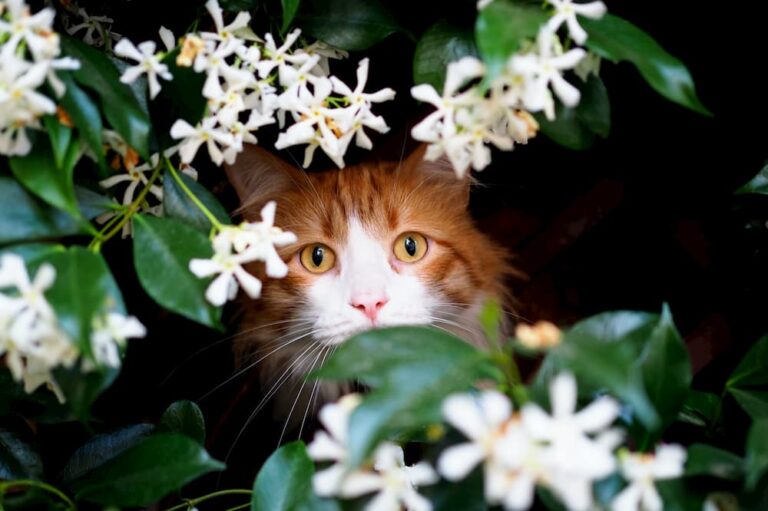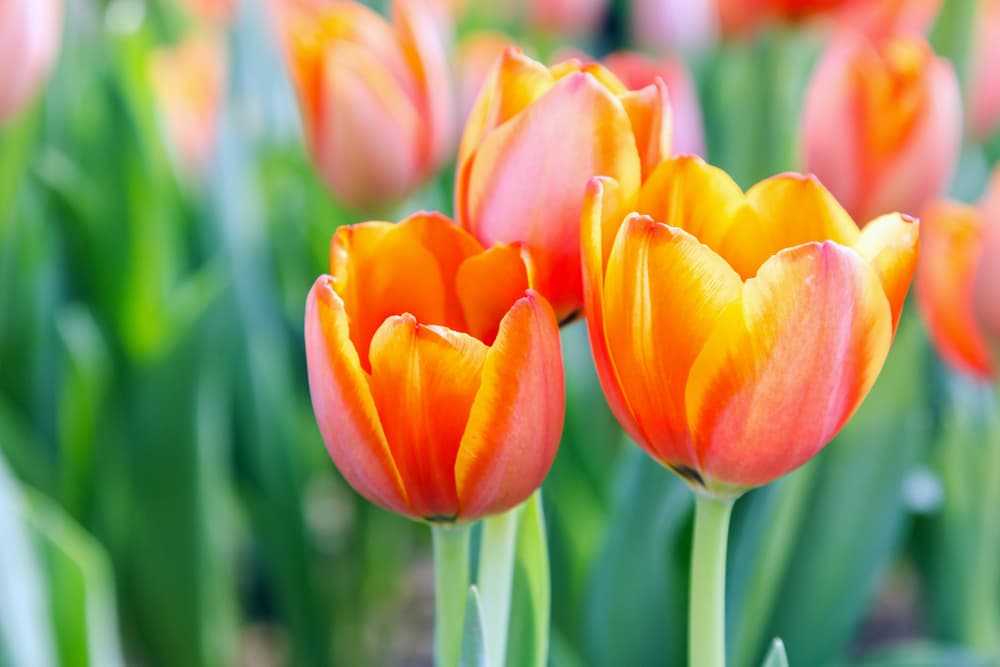10 Flowers That Are Poisonous to Cats

There’s no denying the beauty of freshly-cut tulips or a garden bed of lilies, but flowers like these can make cats sick or even be fatal. The ASPCA Animal Poison Control Center reports that both indoor and outdoor plants are among the top 10 toxins pets most frequently ingest.
“We see regular cases of exposure and intoxication with indoor and outdoor cats,” says Dr. Kevin Kelley, an emergency veterinarian at BluePearl Specialty and Emergency Hospital in Clearwater, Florida.
This doesn’t mean you need to completely give up flowers. Knowing which flowers are poisonous to cats and taking steps to prevent access to them can go a long way to keeping your cat safe.
Flower Toxicity in Cats
Plants produce toxins as a survival mechanism, says Dr. Karyn Bischoff, a board-certified veterinary toxicologist at the New York State Animal Health Diagnostic Center in Ithaca, New York. “Plants can’t run away, so they have to come up with other ways to prevent getting eaten by insects and animals.”
Because cats don’t have hands that can manipulate objects like we do, “they default to using their mouths, which gives some toxins immediate access to their body,” adds Kelley.
Why Do Cats Like Flowers So Much?
If you live with cats, you know how curious they can be, especially when they’re younger. Some cats are attracted to flowers for their taste or texture. “Cats might go for certain plants because they enjoy the mouth feel,” says Dr. Cathy Lund, a veterinarian with City Kitty Veterinary Care for Cats in Providence, Rhode Island.
Cats also have an excellent sense of smell, with about 14 to 20 times the smell receptors that people do, says Kelley. “They are likely to know about a change in their environment and often investigate it, which is when they are exposed,” he says. “Each [cat] is different and some aggressively seek out certain smells when available, while others seem not to care or respond.”
Symptoms of Flower Poisoning in Cats

Depending on the type of flower and amount ingested, symptoms can vary from mild to fatal, says Kelley.
Some of these symptoms include:
“Other plants can damage the liver or kidneys, sometimes irreversibly, or cause cardiac arrhythmias or neurologic side effects, including seizures and even death,” adds Kelley.
Signs of flower poisoning in cats are not always immediately obvious, either. “Their effects are seen with organ damage, manifesting days later, when treatment can be far less effective and damage is permanent.”
A List of Flowers Poisonous to Cats

Veterinarians recommend preventing cats’ access to the following flowers. Keep in mind that any contact with these and other toxic flowers for cats can be dangerous.
“Chewing on some plants is enough to cause toxicity, and ingestion is not always necessary to become poisoned,” says Kelley.
Flowers that are toxic to cats include:
- True lilies and daylilies
- Daffodils
- Hyacinths
- Kalanchoe
- Azalea
- Hydrangeas
- Tulips
- Oleander
- Lily of the valley
- Chrysanthemums
Flowers That Are Safe For Cats

Keep in mind that even non-poisonous flowers for cats can cause some gastric upset. And some can present other challenges, like a rose with its prickly stem.
But, generally, the following flowers are considered safe for cats:
- Lilacs
- Roses
- Sunflowers
- Petunias
- Camellias
- Snapdragons
- Daisies
*These lists are not all-inclusive, so if you’re unsure about any plant, it’s safest to check with a professional.
Flowers and Cats: A Closer Look at Common Varieties
When reviewing any list of non-poisonous or poisonous plants for cats, keep in mind that some names can be misleading.
For example, while the common lilac plant (Syringa vulgaris) is not considered poisonous to cats, the Persian lilac of the Melia genus is. “This plant is very toxic. It can cause more severe gastrointestinal distress, and also muscle weakness, tremors, and seizures if ingested,” says Bischoff.
If in doubt about any plant, it pays to run it past your veterinarian, a garden expert, the ASPCA Animal Poison Control Center, or the Pet Poison Helpline (855-764-7661).
Are Lilacs Poisonous to Cats?

One of spring’s most aromatic flowers, the common lilac (Syringa vulgaris) is a violet-colored shrub that can also come in shades of lavender, burgundy, white, yellow, and blue.
Lilacs have a slightly bitter taste, which may deter cats from eating them. Even if cats do make contact with lilacs, they shouldn’t become seriously ill, says Bischoff, who frequently cuts lilacs in the spring and places them around her own home.
“I think in a worst-case scenario, a cat might get an upset stomach and maybe vomit or have some diarrhea,” she says.
As mentioned above, while the common lilac is not poisonous, the Persian lilac is, so pet owners should know the difference between the two varieties before planting or plucking.
Are Orchids Poisonous to Cats?

Orchids are part of the highly-diverse Orchidaceae family, a group of fragrant, flowering plants that most often present in various shades of pink. But they also come in other colors, including yellow, red, and green. Most orchids are considered safe for cats.
In a worst-case scenario, a cat who ingests orchids might experience mild vomiting and diarrhea, says Bischoff. With more than 25,000 species of orchids however, it’s best to check with a professional.
Are Roses Poisonous to Cats?

The common prickly-stemmed rose (of the Rosa genus) is a perennial shrub that typically yields flowers in red, pink, and yellow.
Experts say roses have not been associated with poisoning in cats. “The worst I would expect would be some mild vomiting and diarrhea,” says Bischoff.
One caveat, however, is the thorny stem of roses, which can cause pain or discomfort to an unsuspecting cat.
Are Tulips Poisonous to Cats?

One of early spring’s typical flowers, tulips actually belong to the lily family (Liliaceae). They contain Tulipalin A and B, chemical compounds that Kelley says are poisonous to cats.
“They are in highest concentration in the bulbs, but the plant if ingested, can cause vomiting, hyper-salivation, diarrhea, and depression,” he adds.
Are Lilies Poisonous to Cats?

According to Pet Poison Helpline, lilies (of the Lilium genus) are one of the top ten cat poisons.
“True lilies (Lilium) and daylilies (Hemerocalis) are so incredibly toxic to cats that they aren’t ever allowed in my house,” says Bischoff. “The prognosis for a cat with lily poisoning is poor to grave.”
All parts of the plant, including the pollen, should be avoided as they can cause kidney failure in cats.
Early symptoms of lily poisoning include excessive salivation or drooling, vomiting, and lethargy, which can range from mild to noticeable, says Kelley.
“Any exposure is considered a severe emergency, and decontamination and detoxification with supportive care is key to long term survival and minimizing damage,” he says.
Are Mums Poisonous to Cats?

Mums are some of autumn’s most widely-grown flowers, presenting in deep orange, burgundy, purple, and yellow. “They contain multiple toxic compounds that can cause vomiting, hyper-salivation, diarrhea, incoordination, and even skin inflammation from contact with some varieties,” explains Kelley.
Ironically, pyrethrin flea sprays were once made from chrysanthemum flowers, says Bischoff. “Pyrethrin is a natural insecticide that can cause some skin irritation, increased salivation, nausea, and vomiting in cats, both because of the effects on nerves and because they have a very bitter flavor.”
Are Sunflowers Poisonous to Cats?

These yellow-petaled flowers with a brown interior disc are cheerful and yield edible seeds.
Sunflowers are also generally considered non-toxic for cats, but veterinarians say they may cause minor stomach upset or vomiting if ingested.
Are Hydrangeas Poisonous to Cats?

Hydrangeas are woody plants that yield rounded clusters of flowers in colors like white, lavender, and blue. Although they look pretty, they can be poisonous to cats.
Some of the compounds in hydrangeas can theoretically break down to cyanide gas in the stomach, “I would definitely advise against letting your cat eat these,” says Bischoff. “I would expect hydrangeas to cause a more severe gastric and intestinal irritation, possibly bloody diarrhea.”
Protecting Cats From Flower Poisoning
Always research the flower you’re planning to purchase, whether it’s an indoor or outdoor plant, recommends Dr. Tina Wismer, senior director at ASPCA’s Animal Poison Control Center and a board-certified veterinary toxicologist. “It is best to familiarize yourself with the list of toxic plants and keep these types of plants out of your home or garden for the health and safety of your pet.”
If you do keep a toxic plant, keep it out of kitty’s reach. “Typically, this includes making a physical barrier,” adds Wismer. “With some plants, a single exposure could be life threatening.”
Cats love to dig through potting soil, says Lund, so pet parents can take steps to make potted plants and flowers unappealing to cats. “If you have larger houseplants, sometimes putting rocks or other deterrents on top of the soil can limit cat access and prevent your plants from becoming another litter box.”
Even if you’re careful about what you plant outside on your own property, you can’t control what your neighbors grow. If your kitty spends any time outdoors, keep him away from any flowers that are toxic to cats.
If you suspect your cat has been exposed to a toxic plant (or are in doubt), contact your veterinarian, ASPCA Poison Control (888-426-4435), or the Pet Poison Helpline (855-764-7661).









